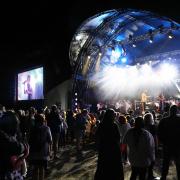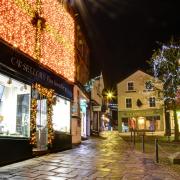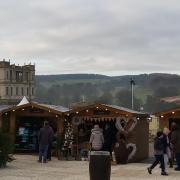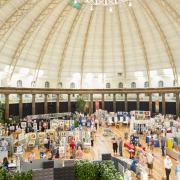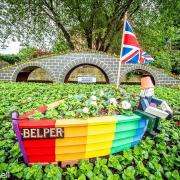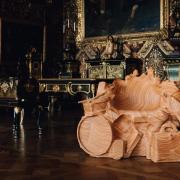This deceptive hamlet 11 miles south-east of Buxton is home to one of the area’s largest employers

Having regularly walked and cycled the High Peak Trail over many years, I have always been intrigued when passing Friden brickworks. An occasional open door into the factory allowed a tantalising glimpse of a vast netherworld, whilst a series of fascinating information boards on the side wall educates passers-by to ‘The History of Friden’. However, I wanted to know more and with the kind permission of Neale Parkin, Managing Director of DSF Refractories and Minerals Limited, I was treated to a tour.
Friden brickworks was established in 1892 by John West, a Victorian entrepreneur and astute businessman. Ironically, as a child he lived on Gas Street in Northampton. By 1881 he was a gas engineer and had developed an improved process to produce town gas from coal – the Glover West Process. He set up the West Gas Improvements company in Manchester and realised the need for heat resistant shapes to use as gas retorts. This brought him to Derbyshire to set up the Derbyshire Silica Firebrick Company.
Millions of years ago volcanic action in this area created deposits of ganister (stone with high silica content), close to which ‘pocket silica’ formed in hollows in the carboniferous limestone. This mix of silica pebbles and clay was ideal for the manufacture of siliceous refractory bricks and provided Mr West with all the ingredients he needed for their manufacture. The perfect site for his new factory was beside the Cromford and High Peak railway line, which he could use to bring in coal and take away the finished products.
West established a branch line to his site as well as a narrow gauge works line from the sand pits that ran through the factory. Following the closure of the main line in 1965, this little internal railway continued to operate until the 1970s and the tracks can still be seen embedded in the concrete floor of the factory and yard.

In 1934 the factory had expanded almost to the size it is today – large parts remain hidden behind the iconic red brick front wall and beneath a complex network of old wooden Belfast trusses. By the 1960s it was still in the hands of the West family, although its name had been changed to DSF Refractories when high alumina bricks were added to the product range. These were used in the steel industry within furnaces and the linings of vessels used to contain molten steel. Business was booming and refractory bricks were exported around the world.
The company has long been one of the biggest employers in the area – in the first half of the 20th century around 400 men worked in the hand-hewn silica pits, many more in the factory. Some families have had three generations who worked here, passing on skills from father to son, and to this day the practice of presenting Long Service Awards continues. Even though the silica pits were closed in the 1990s, with a workforce of around 115 employees – mostly from local villages – Friden remains one of the area’s largest employers. DSF is growing at the moment and also has a number of agency employees.
John West was a fanatical cricketer and set up works cricket and football teams. It is said that when being interviewed you were questioned as to how good a batsman you were – David Mellor from Darley Dale batted for Bakewell, which possibly got him the job, and he stayed for 50 years. The cricket pitch in a neighbouring field was reputedly to county standards. Sadly these days busy lifestyles mean good wages are more important than works social activities, so whist drives, dances and parties are a thing of the past. Years ago, particularly during the war years, many women were employed here, often to make the lighter smaller bricks, but today no females are employed in direct manufacturing. Friden even has its own war memorial, which is decorated with fresh wreaths each year and poignantly sited on a wall in the factory.
BH-F Engineering, based near Oxford, bought the business in 1987 but went into receivership in 1993. A management buyout in 2003 included Neale who had by then worked at Friden for over 20 years. ‘I became the MD and was determined to take the business forward but to retain our standing for high quality. Our British standard registration instils confidence around the world. I also wanted to improve working conditions and keep Friden’s reputation as a friendly, enjoyable place to come to work. Friden is unique; it gets to your heart.’

Since the buyout the firm has invested in equipment which has paid dividends. DSF now make high alumina refractory bricks and blocks for the heat containment industries (glass, steel, cement, petrochemicals). They export to North and South America, Western and Eastern Europe, South Asia, East Asia and Australasia and parts of Africa. The company also processes and sells refractory minerals which are used by other refractory manufacturers and are used in welding, ceramics manufacture and road surfacing – for those skid resistant patches you find when you’re approaching a roundabout.
Friden’s biggest market used to be the steel industry but a competitive and cut-throat market dominated by price rather than quality ended that and the firm decided to concentrate more on sales to the glass industry.
At one time Friden was involved in supplying high quality refractories for the production of glass television screens with lots of business in the USA. Then the flat screen was invented and this area of the glass market disappeared overnight.
Leaving the office block hub of administration with its sales, marketing, management and financial staff, my tour around the plant began through areas designated for processes such as crushing, cleaning, grading, blending, mixing, drying, firing and testing.

First I went to the giant ‘kitchen’ where recipes are made up. Each brick requires a different formulation and over the years they have made thousands of different types of bricks.
In 1998 silica and siliceous products ceased to be made when heat containment requirements changed. Once again DSF diversified and became reliant on imported raw materials. In the yard outside are rows of hoppers with minerals brought in from around the world such as bauxite from China or Guyana and andalusite from France.
Some large or complex shapes are made by a casting process: the mixture is poured into moulds and left to set for up to a day, creating blocks that can weigh up to several tonnes each. The hardeners used involve a chemical reaction that creates a sugary smell more like a toffee factory.
Next we went into the mould shop full of wood and joinery machines. Creating the correct mould is an extreme skill and crucial to production. Every brick or block is precision-made then trimmed or ground to within a millimetre – as near perfect as it is possible to get.

Bricks – some very fragile – are constantly transported around the works. Before the invention of the forklift it was the job of an army of workers with wheelbarrows and trolleys. Today Friden also has custom-made bogies that hold large amounts of bricks securely as they are transported in and out of the kilns.
Modern Vibro and automatic presses are used for standard and less complex shapes, but these can still weigh up to 150kg. Whether pressed or cast, everything has to be allowed to dry before firing. The modern automated kilns fire up to 1,700°C and are currently being converted from running on oil or lpg to natural gas. Still in use is a parallel line-up of 22 old chamber kilns that date from the early 1900s. Bricks are transported in and carefully set in stacks before the kiln is sealed by building a ‘wicket’ (brick door) with old dome bricks and clay cement. This process of firing can take six to eight weeks to complete as a cost-effective sequence of firing passes down the line from one kiln to the next with waste heat used to dry bricks waiting for firing.
Everywhere there were bricks, blocks and more bricks. A production line or a reproduction line. Bricks making bricks, stacked upon blocks. The grinding room was fascinating, containing computerised robotic equipment and diamond compound tips, with expensive modern machinery sitting alongside that dating back 100 years which is still functional and regularly used.
Large stacks of bricks and blocks of varying shapes and sizes were awaiting despatch. One was for a glass bottle factory in Turkey, another to Schott glass in Germany, whilst a pile of cast blocks would soon be heading for the USA.

Next we came to a test site where specific orders for a construction are assembled to make sure each component fits together perfectly before it’s shipped out. Some parts of the factory are still called by their old names – the Barrel Shed where barrels were made to transport goods and minerals long ago now contains pallets that are loaded up and shrink wrapped.
Friden is as far from the sea as it is possible to get in the UK. DSF imports 95 per cent of its materials and exports around 80 per cent of its products. With no railway line alongside, raw materials are either brought in by ship to distant docks and transported here by lorry or brought direct from Europe by road. A recent cost-saving venture involved lorries that were taking British apples to Brittany for cider-making returning with andalusite for Friden.
Friden is getting greener. Some grant funding has helped DSF to bring natural gas onto the site. The kilns have to be converted but long-term this will be cost effective, providing more jobs and emitting less carbon. Water taken from a bore hole on site as well as a holding pond is re-used and recycled. The firm is also trying its best to be sustainable and works hand-in-hand with the Environment Agency and Peak District National Park Authority to minimise waste and keep employment local in an area which is better known for farming and tourism.
Employment in the factory itself still involves some hard manual work. Casting and pressing processes generally operate 18 hours a day on a two-shift basis whilst kilns need 24-hour supervision.
DSF Refractories and Minerals can proudly boast of being the largest refractory manufacturer in the UK and it has some of the best facilities in Europe. DSF remains British, maintaining high standards whilst relishing the challenge to diversify in an ever-evolving market. The company wants to do more in the petro-chemical, high-tech and carbon black industries, which involve heating oil to high temperatures to produce very fine carbon used to make things such as newspaper ink and tyres or heating oil to take out sulphur. Friden’s forte is to make complex, complicated or unusually large bricks and because of this they are unique to the industry. Wherever manufacturing processes require intense heat there will always be a demand for heat-resistant materials.
In future when I walk past on the High Peak trail I will smile to myself in admiration at this Derbyshire firm that has survived for over a 100 years and is thankfully thriving in the 21st century, but also because I now know exactly what goes on inside.






